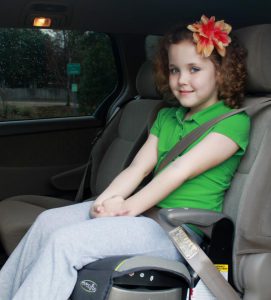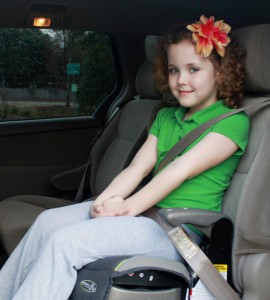
by Ginny Hinton | Feb 10, 2021
If you’re the parent of a “big kid” between the ages of 5 and 12, you’ve probably scratched your head at some point wondering how, where, and in what they should be traveling. There are more options now than ever! Unfortunately, many parents and caregivers make a dangerous choice, without even knowing they could be putting their kids in jeopardy. Following are some of the options for safe travel with older children, including how and why each might work for you:
BELT POSITIONING BOOSTER SEATS
Unlike a car seat, a booster is a positioner, not a child restraint. Its main purpose is to keep the seat belt on the child’s strong hips and collar bone. With a booster, the lap portion of the belt runs under an armrest or clip which holds it low on the hips and upper thighs. This positions the lap belt so that it can’t cut into the child’s soft abdomen, causing serious or potentially life-threatening injuries. Most boosters also position the shoulder belt to keep it flat across the collarbone and protect the neck. An updated study of booster seat effectiveness (Pediatrics, 2009) concluded that children ages 4-8 in boosters are 45% safer from nonfatal injuries than children in seatbelts. The study didn’t find any difference in preventing injury between backless and high-back boosters. Some parents prefer to use high-back boosters because they offer some side-impact protection and give their children a place to lay their heads if they fall asleep. Others prefer the convenience of a lightweight backless booster that can easily travel with the child and be moved between vehicles. A backless booster will NOT work if the vehicle headrest comes below the child’s ears because of the danger of whiplash from rear-end crashes. A child can safely move to a booster seat when he/she has outgrown a car seat by weight and height, as long as the child is mature enough to stay in position while traveling. This usually happens between ages 5-7 but depends on the individual child.

Credit: G. Hinton
VEHICLE LAP-SHOULDER BELTS
How do you know when your child is ready to “graduate” to an adult seatbelt? Because the height and depth of seats vary from vehicle to vehicle, and all children are not made exactly alike, there is no specific height or weight guideline. Instead, there is a simple 5-step test as follows:
• Is your child sitting all the way back in the seat?
• Do the child’s knees reach the edge of the seat without scooting?
• Do the child’s feet touch the floor?
• Does the shoulder belt cross the child’s collar bone and not his/her neck?
• Is the child mature enough to stay in position during the entire trip?
If you can answer “yes” to every question, your child is ready to use an adult seatbelt in that vehicle. If not, no matter what your child’s age, it might be best to continue using a booster seat for a while. When a child is too small sit in an adult seatbelt, the lap belt will slide up onto his/her stomach. In a crash, the belt will keep tightening because there is no bone or other object (i.e. the armrest of a booster) to stop it. During the crash, everything has to stop so fast that it causes the belt to put extreme force on the internal organs and spine, causing the organs to rupture and the spine to snap or fracture. This cluster of injuries is called “seat belt syndrome” and can be severe. Using a booster until your child is big enough to fit the vehicle seat eliminates the risk.

by Ricki McWilliams | May 18, 2015
 Beware of Hidden Dangers
Beware of Hidden Dangers
We all know that taking safety measures, such as using car seats correctly or basic childproofing, for our children is important. But what about “hidden dangers?” One major hidden danger can be the family vehicle. As summertime approaches and the heat is upon us, the dangers of leaving a child in a vehicle can be just as deadly as being involved in a traffic accident.
What’s the Danger?
While abduction may be the first concern that comes to mind when a child is left unattended in a vehicle, another concern is temperature. Outside temperatures ranging from 80 – 90 degrees can translate to temperatures of 120-140 degrees inside a vehicle (even with a window cracked). At such increased temperatures, children are at risk for heat stroke, high fever, dehydration, seizures, stroke, and even death. Even on a milder day (70 degrees), the inside of your car can reach temperatures over 100 degrees. While there may be several reasons a child is left in the vehicle unattended, the National Highway Traffic Safety Administration reports these as the top three:
- Infants and toddlers are simply forgotten in their car seat
- Toddlers or preschoolers sneak into the car to play and can’t get out
- Kids get trapped in the trunk
Heat Isn’t the Only Issue
The dangers of being left alone aren’t limited to a child overheating. Ever think about leaving the car running with the air conditioner on? Even if just for a few minutes, a child can be abducted, engage the transmission and drive off, get stuck in a power window, or press the power locks without knowing how to unlock the doors when you return. When wondering if it’s okay to leave you child in the car ~ just don’t do it.
Safety Tips to Keep Your Kids Safe:
- Don’t leave them in a car, which can quickly heat up, especially on a hot, sunny day
- Always lock your car and secure the keys so your kids can’t get to them
- Warn your kids about playing in the car by themselves without adult supervision
- Install a trunk release mechanism so they can’t get trapped in the trunk
- Get your kids out of the car first, and then worry about getting the groceries, etc., out of the car when you get home
- Make sure child care providers and day care workers have a plan to ensure kids aren’t left in the day care provider’s car or van
Deaths of children in hot cars*
- 2015: 2 (as of May 12, 2015)
- 2014: 30
- 2013: 43
- 2012: 34
- 2011: 33
- 2010: 49
Looking for a Child Passenger Safety Technician to complete a car seat check? Contact Ricki McWilliams, rickim@ufl.edu to find a technician in your area.
For more information on protecting children from other unintentional injuries click here.
Enjoy your summer and enjoy it safely!
*Source: Details are available at http://noheatstroke.org
by Elizabeth | Jun 27, 2014
 Going to the beach or pool is a popular summer activity but did you know a child can drown in as little as one inch of water? Drowning is usually quick and silent. A child will lose consciousness two minutes after submersion, with irreversible brain damage occurring should the child survive. According to the Consumer Product Safety Commission, at least 350 children die each year from drowning, with most occurring in the summer months.
Going to the beach or pool is a popular summer activity but did you know a child can drown in as little as one inch of water? Drowning is usually quick and silent. A child will lose consciousness two minutes after submersion, with irreversible brain damage occurring should the child survive. According to the Consumer Product Safety Commission, at least 350 children die each year from drowning, with most occurring in the summer months.
Keep an eye on young children and prevent them from drowning. Here are a few points to consider when you are around water:
If you have a pool or spa, install a 4-foot fence around it. Besides lowering your insurance premiums, you will prevent direct access to the pool. Children are curious and move quickly; a “self-locking” latch on the gate provides the best obstacle for young children who might want to jump into the pool.
Install safety drain covers. These devices prevent a body part, hair, or clothing from being trapped by the drain cover. All public and private pools as well as spas are required to be fitted with a drain cover per the Virginia Graeme Baker Pool and Spa Safety Act of 2007. For specifications, visit www.poolsafely.gov.
Supervise your child. The most important preventive tactic is to supervise your child around water at all times. This means actively watching them, keeping them within arms’ reach, and not just glancing up every now and then. Don’t assume they will splash and yell for help if they get into trouble. Children can drown quietly in just a few minutes.
Learn to swim. Children can take formal swimming instruction from the age of four years. Water safety skills are included in the training. Swimming programs are available for younger children and babies, but the emphasis is on building confidence and encouraging the child to enjoy water, rather than teaching them to swim. However, children under age five may not be able to use these skills in an emergency so never rely on this to keep them safe.
Use flotation devices. If you buy personal flotation devices, like inflatable vests, make sure they conform to U.S standards – always check the label. You should think of these devices as something to help familiarize your child with water, not as a safety item. A flotation device is not a replacement for supervision. Always supervise your child, even when they are wearing their personal flotation device, in case they tumble upside-down or slip through the vest.
At the beach: Supervise your child at all times – don’t assume that a beach that was safe in the past is safe now, since the action of waves, weather, and wind can influence depth and currents. If the beach uses a color-coded flag warning system, check the flag color and heed the guidelines. Only take your child to beaches with lifeguard patrols. Make sure your child swims only in the protected area. Teach your child to float and raise an arm to signal for help from a lifeguard.
Going to the beach or pool is a lot of fun – keep it safe and always be alert around children. Have a great and safe summer!
by Ginny Hinton | May 12, 2014

New bill would require booster seats for children four years old through age five.
For several years, Florida has been the most dangerous state for children between the ages of 4 and 10 traveling in vehicles. Florida is currently one of only two states in the nation that lacks a booster seat bill for older children – and the only state that allows 4-year-olds to ride in an adult seatbelt.
Booster seats are needed for the simple reason that seat belts are designed to fit adults – specifically the “average” adult male. When a child under age 8 (on average) or under 4’ 9” tall and 80 pounds sits in an adult seatbelt, the lap belt tends to ride up onto his or her stomach. In a crash the belt tightens to keep the child from being ejected. It cuts through the soft stomach and the first bone to stop it is the spinal cord. This is known as “seat belt syndrome”. It can cause severe injuries including internal bleeding and even paralysis. A booster seat “boosts” the child up about six inches so the belt fits below the stomach and can restrain the child properly without causing injury. Using a booster seat reduces your child’s risk of injury by about 60%.
In Florida, some kids are about to get a safety “boost”. The Florida House and Senate just passed the revisions to Florida Statute 316.613 with Bill 225. If signed by Governor Scott, the new regulations will take effect on January 1, 2015. The new law will require children aged 4 through 5 years old to travel in a car seat or booster, NOT an adult seat belt. Unpaid drivers who are not in the child’s immediate family, children being transported for medical emergencies and children with a medical condition necessitating an exception are exempt from the law.
While this law by no means provides adequate protection for Florida’s older children, it is at least a step in the right direction. By a slim margin, Florida will no longer be the most unsafe state in the nation for child passengers.





